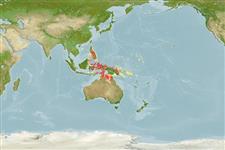Classification / Names
Common names from other countries
Main reference
Size / Weight / Age
Max length : 8.4 cm TL male/unsexed; (Ref. 6340)
Environment
Marine; demersal
Climate / Range
Tropical, preferred ?
Distribution
Short description
Dorsal
spines
(total): 0;
Dorsal
soft rays
(total): 71-72;
Anal
spines: 0;
Anal
soft rays: 56;
Vertebrae: 43. Preserved, ocular side light greyish-brown with 16-18 narrow, dark bands on body reaching the dorsal and anal fins. Blind side of body generally white with scattered spots, becoming dusky toward body margins. Eyes contiguous with upper eye slightly in advance of the lower; no interorbital scales. Opercular margins with minute tentacles. Ctenoid scales on both sides of the body; tubed lateral line scales cycloid.
IUCN Red List Status (Ref. 115185)
Threat to humans
Harmless
Human uses
More information
Age/SizeGrowthLength-weightLength-lengthLength-frequenciesMorphometricsMorphologyLarvaeLarval dynamicsRecruitmentAbundance
ReferencesAquacultureAquaculture profileStrainsGeneticsAllele frequenciesHeritabilityDiseasesProcessingMass conversion
Tools
Special reports
Download XML
Internet sources
Estimates of some properties based on models
Phylogenetic diversity index
PD50 = 0.5000 many relatives (e.g. carps) 0.5 - 2.0 few relatives (e.g. lungfishes)
Trophic Level
3.3 ±0.4 se; Based on size and trophs of closest relatives
Resilience
High, minimum population doubling time less than 15 months (Preliminary K or Fecundity.)
Vulnerability
Low vulnerability (15 of 100)
Price category
